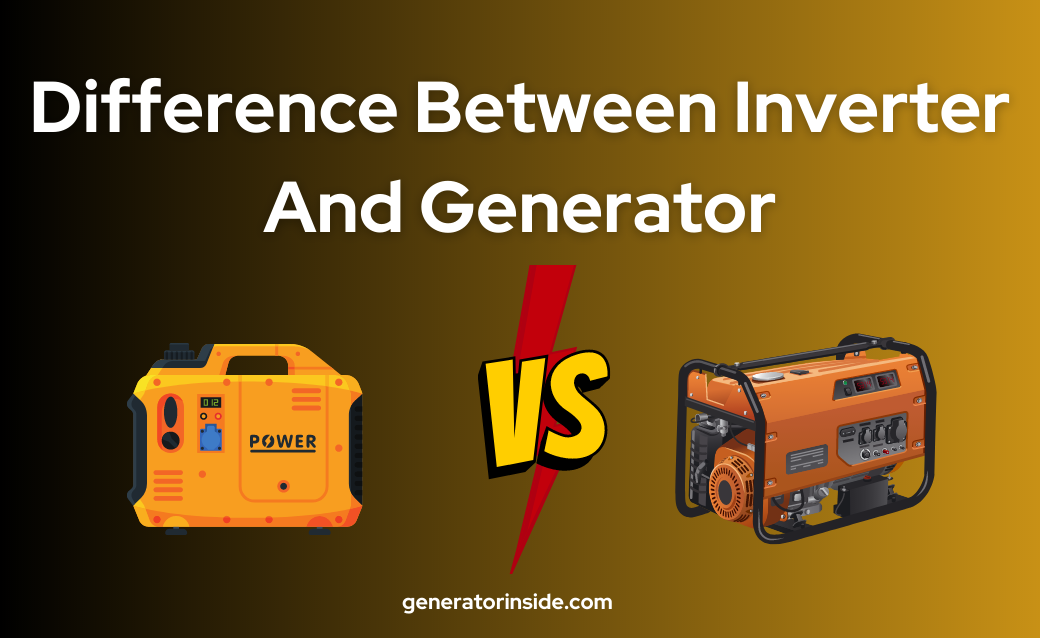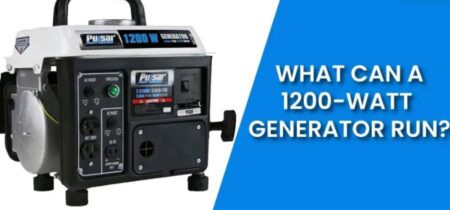
When it comes to generating electricity for off-grid or backup power, you have two primary options: a generator or an inverter. Both are capable of producing electricity, but they work differently and have unique advantages and disadvantages. In this blog post, we will explore the difference between inverter and generator, and help you decide which one is right for your needs.
How do Generators Work?
A generator is a crucial piece of equipment designed to provide electricity during power outages or in remote locations. The main component of a generator is the engine, which can be powered by gasoline, diesel, or natural gas. This engine drives a rotor connected to the engine’s shaft, converting the engine’s energy into mechanical energy.
To maintain proper generator output, the rotor must spin at a specific speed, known as the rated speed. In North America, this is typically 3,600 revolutions per minute (RPM), while in Europe and other regions, it is 3,000 RPM. The rated speed is essential as it determines the frequency of the alternating current (AC) power generated by the generator, which is 60 Hz in North America and 50 Hz in Europe and other parts of the world.
As the rotor spins, it creates a magnetic field around a stationary component called the stator. The stator houses copper coils or windings wound around an iron core. The spinning rotor’s magnetic field induces an electrical current in the copper coils of the stator through a process called electromagnetic induction. The electricity generated in the stator is typically in the form of AC, which is the standard type of electrical power used in homes and businesses.
To ensure the generator operates at the correct speed, it is equipped with a governor. This device controls the amount of fuel delivered to the engine, thereby regulating the engine’s speed. The governor increases or decreases the fuel delivery depending on whether the engine speed falls below or exceeds the rated speed.
The generator’s output depends on various factors, such as the engine’s size and power, the number of coils in the stator, and the rotor’s spinning speed. Generators are typically measured in watts, with sizes ranging from a few hundred watts to several megawatts.
Finally, the electrical power produced by the generator is delivered to a load, which could be any device consuming electrical power, from a light bulb to a large machine. The electrical power is transmitted from the generator to the load through a series of wires and transformers.
How do Inverters Work?
Inverters are essential devices that convert the direct current (DC) electricity into alternating current (AC) electricity, allowing for the use of AC power in homes and businesses. The inner workings of inverters and the process of converting DC power into AC power.
- Main component: The primary component of an inverter is a power transistor, which is a semiconductor device responsible for switching the DC power on and off at a very high frequency, usually several thousand times per second.
- Conversion process: The switching action of the power transistor generates a series of pulses. These pulses are then sent to a transformer, which converts the DC pulses into AC power.
- Inverter size: Inverter sizes are typically measured in watts, ranging from a few hundred watts to several thousand watts. The size of the inverter depends on the amount of AC power required for the connected electrical device.
- DC power input: The amount of DC power input required by the inverter depends on the electrical device it is connected to. For instance, if a device needs 100 watts of AC power, the inverter must convert 100 watts of DC power to produce the necessary AC power output.
- AC power output frequency: The frequency of the AC power output is controlled by a crystal oscillator, a device that generates a stable electrical signal at a specific frequency. In North America, the standard frequency is 60 Hz, while in Europe and other regions, the standard frequency is 50 Hz. The crystal oscillator sends a signal to the power transistor, which switches the DC power on and off at the desired frequency.
- Stability and consistency: To maintain stable and consistent AC power output, inverters are equipped with a feedback circuit. This circuit monitors the output voltage and frequency of the AC power, adjusting the power transistor’s switching to ensure stable output. If the output voltage or frequency deviates from the desired level, the feedback circuit will correct the output by adjusting the power transistor’s switching.
Difference between Inverter and Generator
Inverter and generator are both devices used to provide electrical power, but they have distinct differences in terms of their operating principles, power output, and applications. Here is a comparison between inverters and generators:
- Operating principle
Inverter: An inverter converts direct current (DC) electricity into alternating current (AC) electricity by using semiconductor devices called power transistors to switch the DC power on and off at high frequencies. The resulting pulses are transformed into AC power by a transformer.
Generator: A generator produces electricity through the process of electromagnetic induction. An engine (powered by gasoline, diesel, or natural gas) drives a rotor that spins inside a stationary stator, creating a magnetic field. The magnetic field induces an electrical current in copper coils within the stator, generating AC power.
- Power source
Inverter: Inverters typically rely on batteries or solar panels as their source of DC power.
Generator: Generators use internal combustion engines fueled by gasoline, diesel, or natural gas to produce mechanical energy, which is then converted into electrical energy.
- Power output
Inverter: Inverters generally provide a lower power output compared to generators, ranging from a few hundred watts to several thousand watts. They are suitable for small to medium-sized electrical loads.
Generator: Generators can produce a wide range of power outputs, from a few hundred watts to several megawatts. They are suitable for small, medium, and large electrical loads.
- Power quality
Inverter: Inverters produce a stable and clean AC power output, known as pure sine wave power, which is ideal for sensitive electronic devices such as computers, televisions, and medical equipment.
Generator: Conventional generators produce a less stable AC power output, which can cause fluctuations and voltage spikes that may damage sensitive electronics. However, inverter generators combine the benefits of both inverters and generators, providing clean and stable power like an inverter while utilizing an engine as a power source.
- Noise level and fuel efficiency
Inverter: Inverters are generally quieter and more fuel-efficient compared to generators because they do not have internal combustion engines.
Generator: Generators tend to be louder and less fuel-efficient due to the combustion engine used for power generation.
- Applications
Inverter: Inverters are commonly used in residential and recreational applications, such as powering small appliances, electronics, and off-grid solar systems.
Generator: Generators are often used in commercial, industrial, and residential settings for backup power during power outages, powering large appliances or machinery, and providing electricity in remote locations.
Advantages of Generators
- Reliable Power Source
Generators are a reliable source of power when there is no access to the grid, or when the grid power is down. They can provide power for a long period, making them ideal for long-term power outages or remote locations.
- Portable
Many generators are portable, which means they can be easily moved from one location to another. This is especially useful for construction sites or outdoor events where power is needed in different locations.
- Flexible
Generators come in a variety of sizes and types, which makes them versatile and adaptable to different situations. They can be used to power a single appliance or an entire building, depending on their capacity.
- Cost-effective
Generators are generally less expensive than installing a permanent power supply, especially in remote locations where the cost of running power lines can be prohibitive.
- Easy to operate
Generators are generally easy to operate, and many come with automatic start-up and shut-off features. This makes them an ideal power source for those who are not familiar with electrical systems.
- Environment friendly
With the increasing availability of generators that run on propane, natural gas, and other clean fuels, generators can be a more environmentally friendly option than traditional gasoline-powered generators. They emit fewer pollutants and are quieter than gasoline-powered generators.
- Standby power
Generators can be used as standby power, which means they can automatically start up and provide power when the grid goes down. This is especially useful for critical applications such as hospitals, data centers, and emergency response centers.
Disadvantages of Generators
- Noise
Generators can be noisy, especially larger models that are used to power homes or commercial buildings. This can be a nuisance in residential areas or outdoor events where noise levels need to be kept to a minimum.
- Fuel Costs
Generators can be expensive to operate, especially if they are used for extended time. The cost of fuel can quickly add up, especially if gasoline-powered generators are used.
- Environmental Impact
Traditional generators can have a negative environmental impact, as they produce emissions and noise pollution that can harm wildlife and ecosystems. In addition, spills or leaks of fuel or oil can contaminate the environment.
- Maintenance
Generators require regular maintenance to keep them in good working order, including oil changes, filter replacements, and other routine maintenance tasks. This can be time-consuming and expensive, especially if a professional is required to perform the maintenance.
- Installation
Installing a generator can be a complex and expensive process, especially if it requires the installation of a transfer switch or other equipment. This can add significantly to the overall cost of the generator.
- Size and Weight
Larger generators can be heavy and bulky, making them difficult to transport and maneuver. This can be a problem for construction sites or outdoor events where power is needed in different locations.
- Limited Run Time
Many generators have a limited run time, which means they cannot be used continuously for extended. This can be a problem in situations where power is needed for long time, such as during a natural disaster or extended power outage.
Advantages of Inverters
- Energy Efficiency
Inverters are more energy-efficient than traditional generators because they convert DC power into AC power more efficiently, resulting in less wasted energy. This can result in significant savings on fuel costs over time.
- Reduced Noise
Inverters are generally quieter than traditional generators, making them ideal for use in residential areas or outdoor events where noise levels need to be kept to a minimum.
- Lightweight and Portable
Inverters are typically smaller and lighter than traditional generators, making them easier to transport and maneuver. They are often equipped with handles or wheels, which makes them easy to move from one location to another.
- Clean Power
Inverters produce a high-quality AC power output that is free from voltage fluctuations and spikes that can damage sensitive electronic equipment. This makes them ideal for powering electronics such as computers, televisions, and medical equipment.
- Low Maintenance
Inverters require very little maintenance compared to traditional generators, which can require regular oil changes, filter replacements, and other maintenance tasks. Inverters typically only require occasional cleaning and basic maintenance such as changing the spark plugs.
- Flexibility
Inverters come in a variety of sizes and capacities, making them suitable for a wide range of applications, from powering small electronics to providing backup power for an entire home or business.
- Automatic Shutdown
Many inverters come equipped with automatic shutdown features that protect the unit from damage in the event of an overload or other electrical fault. This can help to prolong the lifespan of the inverter and prevent costly repairs.
Disadvantages of Inverters
- Initial Cost
Inverters can be more expensive than traditional generators, especially for larger models that are capable of providing backup power for an entire home or business.
- Limited Capacity
Inverters are typically designed for small to medium-sized power needs. Larger power needs require larger, more expensive inverters, which can be cost-prohibitive for some users.
- Battery Life
Inverters that are designed to be used with batteries can have a limited battery life, which means they may not be suitable for extended power outages or other situations where power is needed for long Cooling Needs. Inverters generate heat during operation, which means they require cooling to prevent overheating. This can add to the overall cost of the inverter and can require additional maintenance.
- Complexity
Inverters are more complex than traditional generators, which can make them more difficult to operate and maintain. They require a basic understanding of electrical systems and electronics to troubleshoot and repair problems.
- Sensitivity to Temperature
Inverters can be sensitive to temperature fluctuations, especially in extreme hot or cold conditions. This can affect their performance and reliability, which may be a concern in certain situations.
- Incompatible with High-Power Devices
Inverters may not be compatible with high-power devices, such as air conditioners or heavy-duty power tools. This is because they may not have the necessary power output or voltage requirements to operate these devices.
Difference between Inverter and Generator Conclusion
There’s a great difference between inverter and generator. Both inverters and generators have their unique advantages and disadvantages. Generators are reliable and provide a high power output, making them ideal for heavy-duty power needs.
However, they can be noisy, expensive to operate, and have a negative environmental impact. In contrast, inverters are quiet, fuel-efficient, and environmentally friendly, making them ideal for small to medium-sized power needs.
They can be more expensive, have limited capacity, and may not be suitable for high-power devices or extended power outages. Ultimately, the choice between an inverter and a generator depends on your specific power needs, budget, and other factors such as noise pollution, environmental impact, and portability. It is important to carefully consider these factors before deciding to ensure that you choose the right option for your needs.
Also Read:
Why is my Generator Blowing White Smoke
How Much Gas Does A Generator Use








